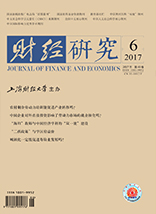我国人口生育政策的调整是政府在我国经济进入中高速发展阶段之后做出的重大决策,对社会经济各个方面会产生重要影响。文章着眼于政策调整、家庭规划和政府公共产品需求,以上海市住房数据为基础,分析了我国"二孩政策"对现阶段学区房价格的影响。文章以特征回归模型为基础,讨论了人口政策变化对学区房价格的影响。研究发现,在人口新政出台后,与临近的普通住房相比,学区房的相对溢价程度更高。文章进一步采用固定边界法,发现优质学区房的溢价涨幅(约为8.6%-11.8%)高于普通学区房(约为2.49%-3.97%),充分说明在人口政策调整后,我国部分家庭对优质教育更加渴望。文章采用匹配回归进行了稳健性检验,仍支持上述研究结论。
“二孩政策”与学区房溢价——基于人口政策变化的政策评价分析
摘要
参考文献
6 石忆邵, 王伊婷.上海市学区房价格的影响机制[J].中国土地科学, 2014, (12):47-55. DOI:10.3969/j.issn.1001-8158.2014.12.007
9 Abadie A, Imbens G W. Large sample properties of matching estimators for average treatment effects[J]. Econometrica, 2006, 74(1):235-267. DOI:10.1111/ecta.2006.74.issue-1
11 Angrist J, Lavy V, Schlosser A. Multiple experiments for the causal link between the quantity and quality of children[J]. Journal of Labor Economics, 2010, 28(4):773-824. DOI:10.1086/653830
12 Barro R J, Becker G S. Fertility choice in a model of economic growth[J]. Econometrica, 1989, 57(2):481-501. DOI:10.2307/1912563
13 Bayer P, Mcmillan R. A unified framework for measuring preferences for schools and neighborhoods[J]. Journal of Political Economy, 2007, 115(4):588-638. DOI:10.1086/522381
15 Black S E. Do better schools matter? Parental valuation of elementary education[J]. Quarterly Journal of Economics, 1999, 114(2):577-599. DOI:10.1162/003355399556070
17 Fan C S. Child labor and the interaction between the quantity and quality of children[J]. Southern Economic Journal, 2004, 71(1):21-35. DOI:10.2307/4135308
18 Guo R, Yi J, Zhang J. Family size, birth order, and tests of the quantity-quality model[J]. Journal of Comparative Economics, http://dx.doi.org/10.1016/j.jce.2016.09.006,2016.
19 Heckman J J, Ichimura H, Todd P E. Matching as an econometric evaluation estimator:Evidence from evaluating a job training programme[J]. Review of Economic Studies, 1998, 65(2):261-294. DOI:10.1111/roes.1998.65.issue-2
20 Hondroyiannis G, Papapetrou E. Demographic transition and economic growth:Empirical evidence from Greece[J]. Journal of Population Economics, 2002, 15(2):221-242. DOI:10.1007/s001480100069
21 Hondroyiannis G, Papapetrou E. Fertility and output in Europe:New evidence from panel cointegration analysis[J]. Journal of Policy Modeling, 2005, 27(2):143-156. DOI:10.1016/j.jpolmod.2004.12.001
22 Imberman S A, Lovenheim M F. Does the market value value-added? Evidence from housing prices after a public release of school and teacher value-added[J]. Journal of Urban Economics, 2016, 91:104-121. DOI:10.1016/j.jue.2015.06.001
23 Kane T J, Riegg S K, Staiger D O. School quality, neighborhoods, and housing prices[J]. American Law and Economics Review, 2006, 8(2):183-212. DOI:10.1093/aler/ahl007
24 La V. Capitalization of school quality into housing prices:Evidence from Boston Public School district walk zones[J]. Economics Letters, 2015, 134:102-106. DOI:10.1016/j.econlet.2015.07.001
25 Li H, Zhang J, Zhu Y. The quantity-quality trade-off of children in a developing country:Identification using Chinese twins[J]. Demography, 2008, 45(1):223-243. DOI:10.1353/dem.2008.0006
26 Rosenbaum P R, Rubin D B. The central role of the propensity score in observational studies for causal effects[J]. Biometrika, 1983, 70(1):41-55. DOI:10.1093/biomet/70.1.41
27 Rosenzweig M R, Zhang J. Do population control policies induce more human capital investment? Twins, birth weight and China's "One-Child" Policy[J]. Review of Economic Studies, 2009, 76(3):1149-1174. DOI:10.1111/roes.2009.76.issue-3
29 Ross S, Yinger J. Sorting and voting:A review of the literature on urban public finance[A].Cheshire P, Mills E S.Handbook of regional & urban economics (Vol. 3)[C]. Amsterdam:Elsevier, 1999.
引用本文
李雪松, 陈曦明, 方芳, 等. “二孩政策”与学区房溢价——基于人口政策变化的政策评价分析[J]. 财经研究, 2017, 43(6): 93–104.
导出参考文献,格式为:





 10038
10038  8012
8012

